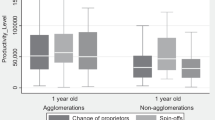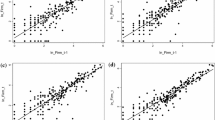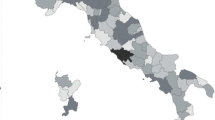Abstract
This paper investigates to what extent determinants of the rate of independent start-ups and the rate of new subsidiaries are different. Using a regional database for the Netherlands over the period 1988–2002, we investigate the impact of two types of agglomeration effects, localization and urbanization, while controlling for a range of economic variables. We find urbanization economies to be particularly important for the creation of new subsidiaries while localization economies are more important for the creation of independent new ventures. Finally, the effect of agglomeration variables is found to be stronger for manufacturing industries compared to services industries.

Similar content being viewed by others
Notes
These studies find a positive net effect of the number of start-ups on regional employment growth. In contrary to most studies that use gross entry, Bosma et al. (2006) investigate the impact of turbulence (sum of entries and exits) on growth of total factor productivity for the Netherlands. They find a positive effect for services and no effect for manufacturing.
However, the relevance of some demographic determinants heavily depends on the regional scale of analysis. For example there is often very limited regional variation in age distributions and practically none in gender distributions within countries at the NUTS1 or NUTS2 level.
In our data base registrations of new independent startups are separated from registrations of new subsidiaries and new branch plants.
Note that these correlations refer to the absolute numbers of the two modes of entry, whereas the correlations presented earlier referred to entry rates.
These are based on item 1 of a five-item Corop-measure on the degree of urbanization that is formed by information at the zip-code level and provided by Statistics Netherlands. In this measure item 1 represents the percentage of people in the Corop region who live in a highly urbanized area and item 5 represents the percentage in a highly rural area.
If we use workforce as scaling variable in both equations, the SUR estimates of the unemployment rates are non-significant for both modes of entry. The non-robustness of the effect of this variable is in line with the mixed results found in the literature, see Table 1.
Also, many low-tech services (new) firms in rural areas sustain the viability of small village communities.
References
Arauzo-Carod, J.M., & Teruel-Carrizosa, M. (2005). An urban approach of firm entry: The effect of urban size. Growth and Change, 36(4), 508–528.
Armington, C., & Acs, Z. (2002). The determinants of regional variation in new firm variation. Regional Studies, 36(1), 33–45.
Ashcroft, B., Love, J. H., & Malloy, E. (1991). New firm formation in the British counties with special reference to Scotland. Regional Studies, 25, 395–409.
Audretsch, D. B., & Fritsch, M. (1994a). The geography of firm births in Germany. Regional Studies, 28(4), 359–365.
Audretsch, D. B., & Fritsch, M. (1994b). On the measurement of entry rates. Empirica, 21, 105–113.
Audretsch, D. B., & Keilbach, M. (2004). Entrepreneurship capital and economic performance. Regional Studies, 38, 949–959.
Bosma, N. S., De Wit, G., & Carree, M. A. (2005). Modelling entrepreneurship: Unifying the equilibrium and entry/exit approach. Small Business Economics, 25, 35–48.
Bosma, N. S., Stam, E., & Schutjens, V.A.M.J. (2006). Creative Destruction and Regional Competitiveness. EIM Research Report H200624. Zoetermeer: EIM.
Carree, M. A. (2002). Does unemployment affect the number of establishments? A regional analysis for US states. Regional Studies, 36(2), 389–398.
Carree, M. A., & Nijkamp, J. (2001). Deregulation in retailing: the Dutch experience. Journal of Economics and Business, 53, 225–235.
Carree, M. A., & Thurik, A. R. (1996). Entry and exit in retailing: Incentives, barriers, displacement and replacement. Review of Industrial Organization, 11(2), 155–172.
Clark, K., & Drinkwater, S. (1998). Ethnicity and self-employment in Britain. Oxford Bulletin of Economics and Statistics, 60, 383–407.
Coughlin, C. C., & Segev, E. (2000). Location determinants of new foreign-owned manufacturing plants. Journal of Regional Science, 40(2), 323–351.
Davidsson, P., & Wiklund, J. (1997). Values, beliefs and regional variations in new firm formation rates. Journal of Economic Psychology, 18, 179–199
EIM (2002). ‘Een warmer vestigingsklimaat voor het MKB?’ EIM Strategic Study, B200104. Zoetermeer: EIM (in Dutch).
EIM/EZ (2003). Entrepreneurship in the Netherlands; Knowledge transfer: developing high-tech ventures. Den Haag: EIM/Ministry of Economic Affairs.
Evans, D. S., & Leighton, L. S. (1989). The determinants of changes in US self-employment, 1968–1987. Small Business Economics, 1, 111–119.
Evans, D. S., & Leighton, L. S. (1990). Small business formation by unemployed and employed workers. Small Business Economics, 2, 319–330.
Figueiredo, O., Guimaraes, P., & Woodward, D. (2002). Home–field advantage: Location decisions of Portuguese entrepreneurs. Journal of Urban Economics, 52, 341–361.
Fotopoulos, G., & Spence, N. (1999). Spatial variations in new manufacturing plant openings: Some empirical evidence from Greece. Regional Studies, 33, 219–229.
Frenken, K., Van Oort, F.G, Verburg, T., & Boschma, R.A. (2005). Variety and regional economic growth in the Netherlands. Papers in Evolutionary Economic Geography, 05.02. Utrecht: Utrecht University, Urban & Regional Research Centre.
Fritsch, M. (1997). New firms and regional employment change. Small Business Economics, 9, 437–448.
Fritsch, M., Brixy, U., & Falck, O. (2006). The effect of industry, region, and time on new business survival—A multi-dimensional analysis. Review of Industrial Organization, 28, 285–306.
Fritsch, M., & Mueller, P. (2006). The evolution of regional entrepreneurship and growth regimes. In M. Fritsch, & J. Schmude (Eds.), Entrepreneurship in the Region. International Studies in Entrepreneurship, 14. New York: Springer.
Fritsch, M., & Schmude, J. (2006). Entrepreneurship in the region. International Studies in Entrepreneurship, 14. New York: Springer.
Gabe, T., (2003). Local industry agglomeration and new business activity. Growth and Change, 34(1), 17–39.
Holl, A. (2004). Transport infrastructure, agglomeration economies, and firm birth: Empirical evidence from Portugal. Journal of Regional Science, 44, 693–712.
Hoover, E. M., & Vernon, R. (1962). Anatomy of a metropolis. New York: Anchor Books.
Johnson, P., & Parker, S. C. (1996). Spatial variations in the determinants and effects of firm births and deaths. Regional Studies, 30(7), 679–688.
Keeble, D., & Walker, S. (1994). New firms, small firms and dead firms: Spatial patterns and determinants in the United Kingdom. Regional Studies, 28(4), 411–427.
Kihlstrom, R. E., & Laffont, J. J. (1979). A general equilibrium entrepreneurial theory of firm formation based on risk aversion. Journal of Political Economy, 87, 719–749.
Kihlstrom, R. E., & Laffont, J. J. (1983). Taxation and risk taking in general equilibrium models with free entry. Journal of Public Economics, 21, 159–181.
Kitson, M., Martin, R., & Tyler, P. (2004). Regional competitiveness: An elusive yet key concept? Regional Studies, 38(9), 991–999.
Kleinknecht, A., & Poot, T. P. (1992). Do regions matter for R&D? Regional Studies, 26(3), 221–232.
Mansfield, E. (1962). Entry, Gibrat’s Law, innovation, and the growth of firms. American Economic Review, 52(5), 1023–1051.
Nyström, K. (2005). Determinants of regional entry and exit in industrial sectors. CESIS Electronic Working Paper Series, 33.
Orr, D. (1974). The determinants of entry: A study of the Canadian manufacturing industries. The Review of Economics and Statistics, 56(1), 58–66.
Parker, S. C. (2004). The Economics of self-employment and entrepreneurship. Cambridge: Cambridge University Press.
Porter, M. E. (1990). The competitive advantage of nations. New York: Free Press.
Porter, M. E. (2000). Location, competition and economic development: Local clusters in the global economy. Economic Development Quarterly, 14(1), 15–31.
Reynolds, P. D. (1994). Autonomous firm dynamics and economic growth in the United States, 1986–1990. Regional Studies, 28(4), 229–442.
Reynolds, P. D., Storey, D. J., & Westhead, P. (1994). Cross-national comparisons of the variation in new firm formation rates. Regional Studies, 28(4), 443–456.
Reynolds, P. D., Miller, B., & Maki, W. R. (1995). Explaining regional variation in business births and deaths: U.S. 1976–88. Small Business Economics, 7, 389–407.
Siegfried, J. J., & Evans, L. B. (1994). Empirical studies of entry and exit: a survey of the evidence. Review of Industrial Organization, 9, 121–155.
Stam, E. (2007) Why butterflies don’t leave; Locational behaviour of entrepreneurial firms. Economic Geography, 83(1), 27–50.
Stam, E. (2008). Entrepreneurship. In R. Kitchin, & N. Thrift (Eds.), The International Encyclopedia of Human Geography. Oxford: Elsevier Science. In press.
Storey, D. J. (1991). The birth of new firms—Does unemployment matter? A review of the evidence. Small Business Economics, 3, 161–178.
Sutaria, V., & Hicks, D. (2002). The determinants of new firm formation dynamics. Paper presented at European Regional Science Association Conference 2002, Dortmund.
van Stel, A. J., & Nieuwenhuijsen, H. R. (2004). Knowledge spillovers and economic growth: An analysis using data of Dutch regions in the period 1987–1995. Regional Studies, 38, 393–407.
van Stel, A. J., & Storey, D. J. (2004). The link between firm births and job creation: Is there a Upas tree effect? Regional Studies, 38, 893–909.
van Stel, A. J., & Suddle, K. (2006). The impact of new firm formation on regional development in the Netherlands. EIM Research Report, H200604. Zoetermeer: EIM.
Van Oort, F. G., & Stam, E. (2005). Agglomeration economies and entrepreneurship: Testing for spatial externalities in the Dutch ICT industry. Papers on Entrepreneurship, Growth and Public Policy, 09-2005. Jena: Max Planck Institute of Economics–Entrepreneurship, Growth and Public Policy Group.
Verheul, I., Wennekers, A. R. M., Audretsch, D. B., & Thurik, A. R. (2002). An eclectic theory of entrepreneurship. In D. B. Audretsch, A. R. Thurik, I. Verheul, & A. R. M. Wennekers (Eds.), Entrepreneurship: Determinants and Policy in a European–US Comparison (pp. 11–81). Dordrecht: Kluwer.
Verheul, I. (2005). Is there a (fe)male approach? Understanding gender differences in entrepreneurship. ERIM Ph.D. Series Research in Management, Erasmus University Rotterdam, The Netherlands.
Wennekers, A. R. M. (2006). Entrepreneurship at country level; Economic and non-economic determinants. ERIM Ph.D. Series Research in Management, Erasmus University Rotterdam, The Netherlands.
Werker, C., & Athreye, S. (2004). Marshall’s disciples: Knowledge and innovation driving regional economic development and growth. Journal of Evolutionary Economics, 14, 505–523.
Wever, E. (1984). Nieuwe Bedrijven in Nederland (in Dutch). Assen: Van Gorcum.
Zellner, A. (1962). An efficient method of estimating seemingly unrelated regressions and tests for aggregation bias. Journal of Statistical Association, 57, 348–368.
Zellner, A. (1963). Estimators for seemingly unrelated regression equations: Some exact finite sample results. Journal of Statistical Association, 58, 977–992.
Acknowledgement
The paper has been written in the framework of the research program SCALES, which is carried out by EIM and is financed by the Dutch Ministry of Economic Affairs. The authors gratefully acknowledge the comments from Erik Stam and Veronique Schutjens on an earlier draft. The usual disclaimer applies.
Author information
Authors and Affiliations
Corresponding author
Rights and permissions
About this article
Cite this article
Bosma, N., van Stel, A. & Suddle, K. The geography of new firm formation: Evidence from independent start-ups and new subsidiaries in the Netherlands. Int Entrep Manag J 4, 129–146 (2008). https://doi.org/10.1007/s11365-007-0058-8
Published:
Issue Date:
DOI: https://doi.org/10.1007/s11365-007-0058-8




